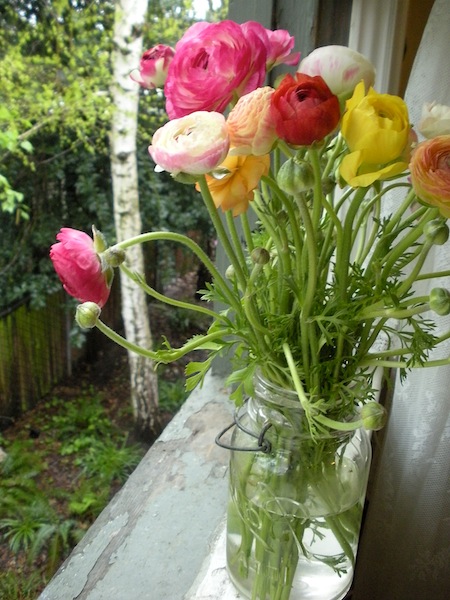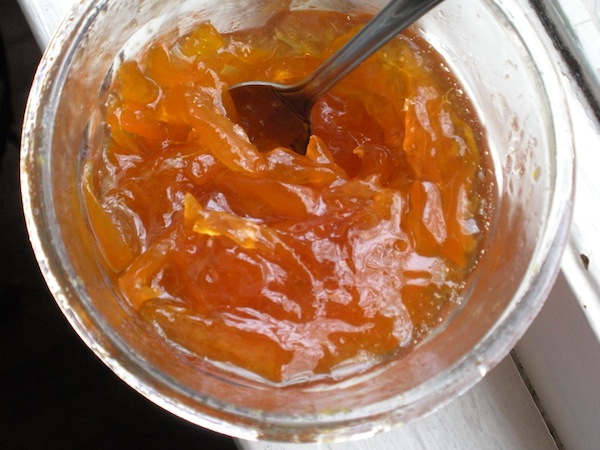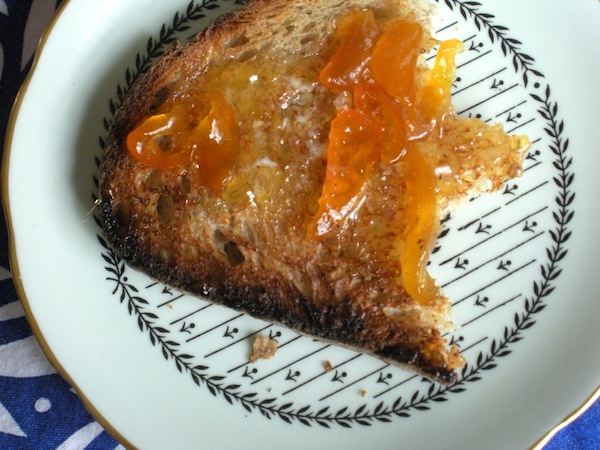
We’ve already told you why White Hinterland‘s Kairos LP is one of the year’s finest makeovers–an abrupt but seamless shift from smoky, jazzy folk tunes to beat-heavy pop and R&B. As if that wasn’t impressive enough, singer/multi-instrumentalist Casey Dienel is also one hell of a cook. So now that spring has officially sprung at White Hinterland’s Portland headquarters (see the photo below), we asked Dienel to share one of her favorite seasonal recipes: kumquat marmalade.

When I’m home from the helter skelter, balls-to-the-wall nature of touring, all I want to do is cook for myself and settle back into domesticity. It may come as surprise to you that a lot of musicians I know are like this–excellent cooks and crafters. They’re homebodies. Touring is an obstacle course of the external: new cities, new people, new variables every single night. When I’m home, I want the opposite. I want to stay in. I want to watch Citizen Kane and roast a chicken. I want to have a dinner party. I do not want to go to the bar.
I collect jams and jars of things from the road. When we were in Europe two years ago, I brought back passion fruit curd from Ireland and two different kinds of marmalade. My suitcase weighed as much as a dead man. I am a little obsessed with marmalade in particular–when it’s done right, it’s more sour than sweet, and there’s just nothing better for me than a thick, crusty slice of burnished toast slathered in butter and marmalade.
This recipe for kumquat marmalade symbolizes how I like to do things at home. I prefer making my own jams and marmalades because I don’t like things to be too sweet. In this recipe, I always add a splash of Grand Marnier (which I always keep on hand because I love to make Sidecars) towards the end. Occasionally I toss in a vanilla bean or a star anise pod, but my favorite way is just plan and simple like this. Jam can simmer on the stove while I am practicing or writing; it’s pretty fool-proof.
It’s a little time-consuming in the beginning, but it’s also really meditative for me. First you slice up the kumquats and set aside the seeds. I put the seeds in a muslin sachet and soak that with the kumquats overnight to coax out the pectin. It’s a small batch, meant to be kept in the fridge rather than canned and I go through it within a matter of weeks. I really love it on top of pain d’epice, sometimes embellishing with a thin slice of Iberico ham.

INGREDIENTS:
1 1/2 pints of kumquats
2 1/2 cups of sugar
4 cups of water
A splash of Cointreau or Grand Marnier
1 4×4 inch piece of muslin or cheese cloth
Some kitchen twine
DIRECTIONS:
1. Wash the kumquats in cold water. Use a small, sharp paring knife to slice them thinly lengthwise, removing the seeds and tossing them into a small bowl as you go to reserve them. This takes a little while, so make yourself cozy and maybe find some diversion (music/movie/whatevs) to help the time pass quickly. Sometimes I set up shop on the patio on nicer days so I can soak up a little bit of sun in the process. Place the sliced kumquats in a stainless steel 2-4 qt saucepan and add to this the water.
2. Take the reserved seeds and place them in a square of muslin. Gather the muslin at the sides to make a sachet and tie off with a piece of kitchen twine. Add the sachet to the saucepan.
3. Bring the kumquats to a boil, then simmer over low heat for 5 minutes. Remove from heat and let this sit out overnight on the counter for 24 hours. (I usually start this recipe the afternoon beforehand, around 4 p.m.)
4. The next day, return the pot to the stove and bring to a boil. Simmer once again over low heat until the peels are very tender. The mixture will turn a brilliant orange color. Remove the sachet of seeds and add to this the sugar and bring to a boil. At this point I like to add a splash of Grand Marnier.
5. The marmalade should simmer for anywhere between 1-2 hours. Stir every so often and skim off any of the scummy foam that comes to the surface with a stainless steel slotted spoon. Usually I take mine off the heat at the 90-minute mark. To test if it’s ready, keep a clean porcelain plate in the freezer. When you want to test the marmalade, remove the plate from the freezer and put a small spoonful of jam in the center. If it runs, it needs more time. If the gel stays put, the marmalade has set up and is ready to transfer.
6. Transfer the jam to jars that have been scrubbed clean with hot, soapy water–sterilized with boiling water. I often just put it in a glass jar and store in the freezer. You can also can it at this point if you like.
YIELDS: 1/2 pint of jam (about two smaller jars).


